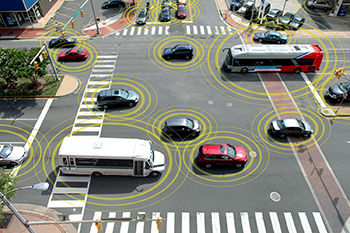By SEMA Editors
 The latest tech alert from the SEMA Garage and Emerging Trends and Technology Network (ETTN) covers the five levels of vehicle automation for connected and autonomous vehicles (CAVs) defined by the National Highway Traffic Safety Administration (NHTSA) and SAE International. |
The latest tech alert from the SEMA Garage and Emerging Trends and Technology Network (ETTN) covers the five levels of vehicle automation for connected and autonomous vehicles (CAVs) defined by the National Highway Traffic Safety Administration (NHTSA) and SAE International.
Each succeeding level of automation, from zero to four, builds increasing vehicle connectivity and autonomy functionality. Many new vehicles and aftermarket systems are already at Level 2 and approaching Level 3 with Advanced Driver Assistance Systems (ADAS). By the year 2020, 80% of vehicles will have connected car features.
The five levels of vehicle automation include:
- No Automation (Level 0): The driver is in complete and sole control of the primary vehicle controls—brakes, steering, throttle and motive power—at all times.
- Function-Specific Automation (Level 1): Automation at this level involves one or more specific control functions. Examples include electronic stability control or pre-charged brakes, where the vehicle automatically assists with braking to enable the driver to retain control of the vehicle or stop faster than possible if acting alone.
- Combined Function Automation (Level 2): This level involves automation of at least two primary control functions designed to work in unison to relieve the driver of control of those functions. An example of combined functions enabling a Level 2 system is adaptive cruise control in combination with lane centering.
- Limited Self-Driving Automation (Level 3): Vehicles at this level of automation enable the driver to cede full control of all safety-critical functions under certain traffic or environmental conditions to rely on the vehicle to monitor changes in those conditions requiring transition back to driver control. The driver is expected to be available for occasional control, but with sufficient transition time. The Google car is an example of limited self-driving automation.
- Full Self-Driving Automation (Level 4): The vehicle is designed to perform all safety-critical driving functions and monitor roadway conditions for an entire trip. Such a design anticipates that the driver will provide destination or navigation input, but is not expected to be available for control at any time during the trip. This includes both occupied and unoccupied vehicles. While full Level 4 and 5 autonomous vehicle markets are still “blue-sky” markets, more than 80% of cars are forecast to have connected car features by 2020 and a survey shows that 59% of respondents said that connected features influenced their vehicle choice. Performance vehicles, such as the new Ford GT and Nissan GTR, are accelerating the deployment of CAV vehicle technologies and systems. Performance and automated-driving systems blend advanced technology problem solving with brand halo equity to drive the industry forward.
For more information on the ETTN, contact Bryan Harrison at 909-978-6691 or bryanh@sema.org.





